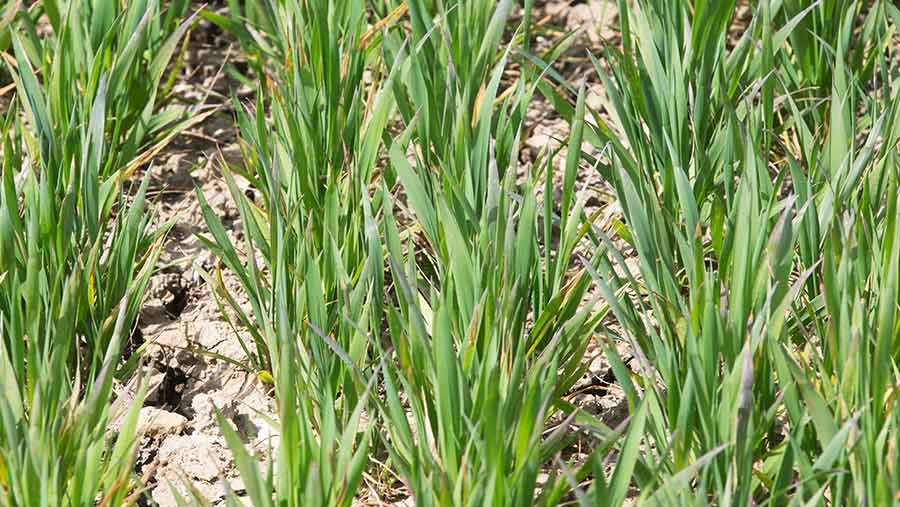Crop Watch: Well-fed plants ride out the dry weather best
 © Tim Scrivener
© Tim Scrivener Different management strategies in the South are showing varying performance in the dry weather for Tod Hunnisett, with crops that received manure continuing to look healthy.
Big variations in crop performance have also been seen in the East, based on both variety and management choices, says Ryan Hudson.
Over in the slightly wetter West, some rain has fallen just in time on crops managed by Neil Potts, who warns that ramularia levels are higher than in previous seasons, justifying a chlorothalonil application.
See also: How one OSR candidate variety can fight disease and pests
Oilseed rape crops in the North are looking very promising, with a prolonged period of flowering and excellent pod formation, writes David Martindale.
West: Neil Potts
 Matford Arable (Devon)
Matford Arable (Devon)
Rain on the last weekend of April came just in time to save many crops from what could have been total disaster.
The region had between 25-50mm of rain at that time. Prior to this many wheat crops had not taken up their nitrogen and were looking very pale.
All spring crops drilled immediately before the rain were struggling to germinate and in places had emerged in a patchy fashion.
Winter wheat crops are variable for a number of reasons, but are improving quickly after the rain. Yellow rust continues to be an issue in susceptible varieties, but is gradually being brought under control.
Timeliness or otherwise of the T0 and T1 applications have been a major factor in how successfully it has been controlled.
Septoria is ever-present, but the recent dry spell has slowed it up considerably and I am expecting good control from the T0 and T1 fungicides.
By the time this goes to print the most forward wheat crops will be receiving their T2 applications.
Winter barley crops on the whole are looking very good indeed and I have high hopes for this crop this year.
The key to success with this crop has been, as ever, getting plenty of nitrogen into the crop early enough.
There are a few crops about where nitrogen applications were delayed and these are looking pretty poor as a consequence.
Ramularia levels seem to be higher than we have seen in previous seasons and the disease in general seems to be growing in importance with each passing season. For this reason I can see chlorothalonil being used increasingly in the barley crop.
Drilling of the maize crop is in full swing and the first crops drilled are now emerged or emerging.
Where no pre-emergence has been applied, these crops will require careful monitoring for weeds to get the timing of the post-emergence herbicide correct.
North: David Martindale

David Martindale
Arable Alliance (Yorkshire)
The dry conditions have affected winter and spring crop establishment across a range of soil types. Flag leaves are emerging in winter wheat crops, so thoughts turn to the T2 fungicide timing.
With the weather being so dry, it is tempting to cut fungicide rates. However, the T2 fungicide coats leaves one and two, which together contribute to 60-70% of yield, so it can soon prove false economy to cut fungicide rates at this key timing.
Also, there is a lot of protectant activity from the fungicide mix to give the persistency required to keep the top yield-forming leaves clean.
There is plenty of septoria on the older leaves and some yellow rust still bubbling away where T0 and/or T1 fungicide timings were delayed. Watch out for mildew appearing, particularly in later-sown crops.
Winter barley T2 fungicides are now being applied and in most cases this is a top-up to protect the new growth until harvest.
Where T1 fungicide timings were delayed some net blotch and rhynchosporium has crept higher up the canopy than ideal, but at least the T2 fungicide should limit their development.
Oilseed rape crops seem to have been flowering forever, with a second fungicide for sclerotinia control applied in some cases.
Pod formation looks excellent and some canopies are quite tall despite delays to nitrogen and plant growth regulator applications. To avoid lodging, these tall crops will not want a lot of rain before harvest.
Spring barley crops are all over the place in terms of establishment, growth stage and yield potential.
The earliest crops are now approaching the T1 fungicide timing, which is often a good opportunity to tidy up any outstanding weeds.
South: Tod Hunnisett

Todd Hunniset
AICC (Sussex)
The trouble with a dry spring is that the crops don’t suffer so much from lack of moisture as they do from lack of nitrogen, exacerbated by the lack of moisture.
You only need to look at fields that had turkey muck, sewage sludge or copious amounts of farmyard manure last autumn to see that they are capable of weathering the drought quite satisfactorily.
Probably a good job these fields haven’t had much rain or they would be flat as pancakes by now.
The trouble with crops that are under stress due to lack of nitrogen is that they become particularly susceptible to disease ingress, especially the rusts and mildew.
This means that despite the dry weather, we still need to spend money on fungicides – we’re just targeting different diseases. Every drill overlap is yellow, hungry and stuffed with disease.
I haven’t pulled a drill for 25 years, so I’m probably out of touch with the practicality, but do we really need 12-18m of double-drilling around every field?
We have been told there is a chance of a bit of rain some time over the next fortnight. If it comes it might salvage some of the crop’s potential. If it doesn’t rain for much longer than that, I fear crop yields may not be recoverable.
All is not so bad, at least it has now warmed up. Winter barley is coming to full ear and will soon be put to bed.
Oilseed rape is coming to the end of a long flowering period with little or no rain and second fungicide sprays look less justified.
Spring sowings look remarkably healthy, with little or no weevil problems on the pulses.
Maize is being drilled into generally good conditions, largely because we have to start sometime. And, problematic though it is, dry weather is much easier to live with.
East: Ryan Hudson

Ryan Hudson
Farmacy (Bedfordshire/Hertfordshire)
The dry weather has brought to the fore the importance of looking after the soil, rotations, appropriate cultivations and the importance of organic matter in making our soils more resilient.
There has also been some big differences in how varieties have coped, not necessarily down to the variety alone, but a combination of factors that will help decisions for future seasons.
Although yield potential may well be affected in some crops, we should use an extreme season such as this to learn as much as possible about the variations across the farms.
Some of the earlier wheat crops are approaching flag leaf emergence and T2 fungicides. The flag leaf is obviously the most important leaf and therefore, where we have eased back at T1 due to the dry, SDHIs are likely to figure at T2 to provide good persistence.
Mildew is proving to be the most problematic disease at the moment, so ensure you check the base of the crop for infection.
This may not seem an issue at present, but in the thicker crops it can quickly move up the canopy on to the ear, significantly affecting quality.
Winter beans are the stand-out crop at the moment, which highlights the benefits of being able to fix your own nitrogen.
As first pods start to set, Syngenta BruchidCast can help with decision-making about insecticide applications. Two consecutive days of 20C after first pod set should be the trigger for the first application.
If we get rain, I would envisage a flush of broad-leaved weeds that will need to be controlled in spring cropping quickly, as crops will grow away rapidly.
Timings and intervals therefore need to be carefully planned, especially on crops such as spring oats, where we should not mix plant growth regulators and herbicides.

